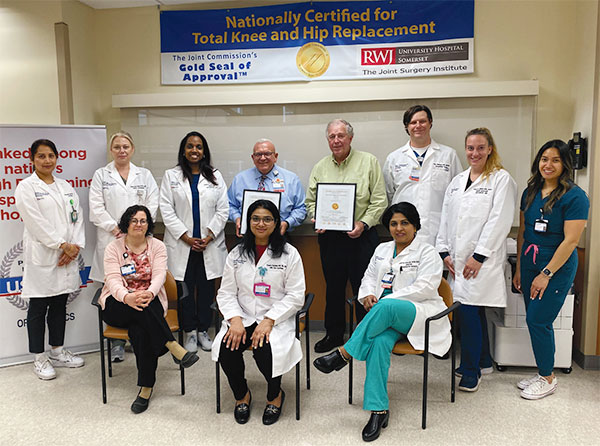“It was like a miracle. I realized that I needed to stop suffering and start living.”

At New Brunswick High School, Robin Glover’s students call her Ms. Glover. But to her friends and family, she’s the Bionic Woman. “Some people even call me the Queen of Replacements,” she says.
The nicknames come for good reason. Over the past seven years, Robin has undergone four successful total joint replacement surgeries.
Today, with two new knees and two new hips, she’s full of energy and living pain-free. “I can just feel how my life is going to be so much better,” she says. From childhood, Robin was always active. She was a high school cheerleader and an avid jogger. “I had some issues with my knees, but nothing serious,” she says. But by her 40s, she was experiencing daily, worsening pain. “I was told that I’d definitely need at least one knee replacement someday,” she says.
Then, in 2016, she was diagnosed with breast cancer. Chemotherapy and radiation treatments successfully put her cancer into remission but also seemed to leave her with more pain in both of her knees and her left hip.
By summer 2018, Robin was struggling. “I couldn’t tie my shoes or get in and out of a car without pain, and I needed help to get dressed,” she says. She tried conservative treatments, including injections and three months of physical therapy, but they didn’t resolve her discomfort. She would need a left hip replacement—the first of her four surgeries.
‘The Grand Slam’
It’s rare for people to need multiple joint replacement surgeries, according to orthopedic surgeon Stephen Kayiaros, MD, Medical Director of the Joint Surgery Program at Robert Wood Johnson University Hospital (RWJUH) Somerset, who performed all four of Robin’s surgeries. “I’d estimate that only about 20 percent of my patients need both knees replaced, and only about 15 percent need both hips replaced,” he says. “But getting all four replaced—I call that the grand slam.”

Dr. Kayiaros surmises that genetic factors, side effects from Robin’s chemotherapy treatments and wear and tear on her joints all played a role in Robin’s needing so many total joint replacements.
“When I first saw her, she had significant arthritic disease in both her knees and hips, which is typical of patients who have a genetic predisposition for developing arthritis in major weight-bearing joints,” Dr. Kayiaros says.
Robin felt a dramatic difference after her first hip replacement surgery in 2018. “It was like a miracle,” she says. “I realized that I needed to stop suffering and start living.”
She had her right knee replaced the next year, then her left knee replaced in fourth and final total joint replacement procedure on her right hip.
For both of her hip replacement procedures, Dr. Kayiaros used an anterior approach, a tissue-sparing technique that can lead to less pain, faster recovery and improved mobility.
“It’s been amazing,” Robin says. “My new hips and knees feel like they’re a natural part of my body.”
Ingredients of Success
Throughout her journey, Robin relied on support from her grown daughter, her friends, her students and Dr. Kayiaros and his team. “He’s my buddy,” Robin says of Dr. Kayiaros. “He has this big smile, and he makes you feel comforted. When I saw him right before my last surgery, I told him I was sad because I wouldn’t get to see him as much anymore.”
According to Dr. Kayiaros, Robin’s upbeat outlook played a key role in her successful recoveries. “She had reasonable expectations and a positive attitude— and that’s a perfect recipe for excellent outcomes from total joint replacement,” he says.
Today’s hip and knee implants have excellent longevity—“about 25 to 30 years on average,” Dr. Kayiaros says, which means Robin isn’t likely to need any additional surgeries.
Robin is now able to undertake activities that she hasn’t enjoyed for years. Soon after her most recent surgery, she began riding an exercise bike in physical therapy and has continued embracing low-impact aerobics—and even set her sights on taking a dance class.
“Everything is better now,” she says. “Even driving to the store is easier because I’m pain-free.”
A Recognized Leader in Joint Replacements

Robert Wood Johnson University Hospital (RWJUH) Somerset has earned the Gold Seal of Approval from The Joint Commission for total hip and knee replacement surgery. The certification recognizes the hospital’s comprehensive approach to care, including pre-surgery education, rehabilitation and an opioid free pain-relief system. It is the hospital’s sixth consecutive Joint Commission Certification for total hip and knee replacement surgery since 2012.
In addition, U.S. News & World Report has named RWJUH Somerset to its 2024- 2025 Best Hospitals as a High Performing hospital for total hip replacement surgery. This is the highest distinction a hospital can earn in U.S. News’ Best Hospitals Procedures & Conditions ratings.
Curriculum for Recovery
Having four total joint replacements has educated teacher Robin Glover on lessons that she shares with others who need similar surgeries:
- Don’t wait. “Do it while you’re young and strong, so you can make a full recovery.”
- Focus on independence. “Celebrate the small improvements you make each week.”
- Regain your confidence. “Don’t be afraid to walk after surgery. I was already taking stairs and folding laundry in two weeks!”
Learn more about joint replacement surgery at RWJBarnabas Health.
